初三英语语法知识点专题讲解练习----连词
2025年人教版九年级中考专题复习+连词课件

连词定义: 用来连接词、短语或句子的词
连词分类:
连词:and, but, or, so, (for)
并列连词
(Coordinating conjunction)
连词词组: either…or,
neither…nor,not only…but also, both…and, (as well as)
“或者A或者B”
neither A nor B
“既不A也不B”
not only A but also B “不仅A而且B”
【连接主语 时,谓 语“就近原则”】
①Either you or I ___a_m_ going to the party.
(或者你或者我将去晚会。)
②Neither I nor he ___h_a_s_ seen the movie.
连接原因、结果状语从句
1.You should return the digital camera to Sally _____ she will not be angry. A. so that B. because C. before 2. He was hurt ____ badly _____ he had to see a doctor. A. too…to B. so… that C. so that 3.He took off his coat ______ it was too hot in the room. A.And B. since C. but 4. Solo missed the bus ____ he was late for school. A. because B. so C. or
as, because, since , for
中考英语总复习 介词、连词(讲解+练习)

介词和连词中考命题趋势考纲解读(介词和连词在近5年考试中的考查点)1. 熟悉和掌握常用介词和连词的用法。
2. 了解和运用一些常见的介词短语及连词的使用方法。
3. 能正确区分并列连词和附属连词 ,并掌握其用法。
命题预测1. 介词的考查方式以单项选择的形式为主 ,也会在单词拼写、完形填空中进行考查。
2. 据统计 ,介词的常考点有:(1)表示时间的介词 ,如:2019·临沂 ,17题;2019·咸宁 ,30题。
(2)表示地点方位的常用介词 ,如:2019·大庆 ,2题。
(3)表示方式、手段或工具的介词 ,如:2019·云南 ,21题。
(4)介词的常见搭配 ,如:2019·徐州 ,7题。
连词的考点有:(1)并列连词的用法 ,如:2019·绥化 ,6题;2019·临沂,28题。
(2)附属连词的用法 ,如:2019·长春 ,13题;2019·乐山 ,30题。
3. 预计今后中考中介词考查的重点将是其根本用法(同时也要注意介词的常见搭配的情况);连词的考查将以并列连词和附属连词根本含义为重点 ,也要注意考查连词的特殊用法 ,比方:“就近原那么〞 ,不能出现在同一个句子中的连词等。
中考考点清单一、介词概述:介词又叫前置词 ,是一种虚词。
介词是一种用来表示词与词或者词与句之间的关系的词 ,在句中不能单独作句子成分。
介词一定要有宾语 ,充当宾语的一般有名词、代词或相当于名词的其他词、短语或句子。
如:I am in school. in the morningThanks for helping me. What about going for a walk?二、介词的句法功能:介词不能独立在句中作成分 ,介词后必须与名词、代词或动名词构成介词短语在句中充当一个成分 ,表示人、物、事件等与其他人、物、事件等之间的关系。
1. 作定语:The book on the table is mine.2. 作状语:We have breakfast at seven. (表时间);They were late for meeting because of the heavy rain. (表原因);They started the machine by pressing the button. (表方式)3. 作表语:My dictionary is in the bag.4. 作宾语补足语:I found him in the office.三、介词分类:①时间介词;②方位介词;③方式介词;④目的介词;⑤原因介词;⑥运动方向介词;⑦比拟介词等等。
初中英语语法连词讲解及练习
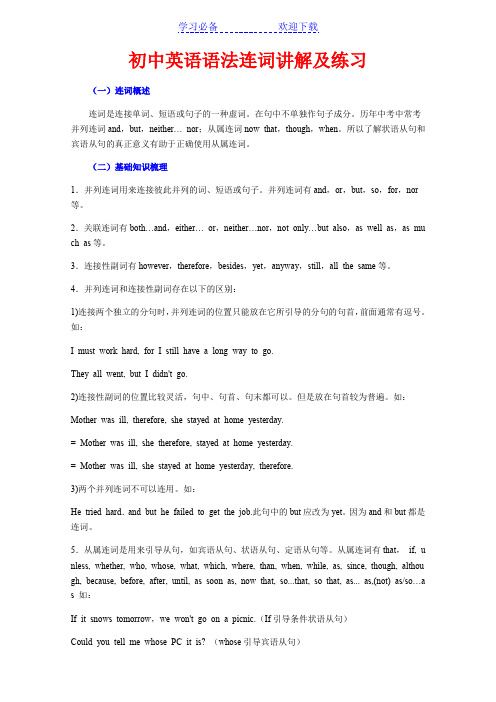
初中英语语法连词讲解及练习(一)连词概述连词是连接单词、短语或句子的一种虚词。
在句中不单独作句子成分。
历年中考中常考并列连词and,but,neither… nor;从属连词now that,though,when。
所以了解状语从句和宾语从句的真正意义有助于正确使用从属连词。
(二)基础知识梳理1.并列连词用来连接彼此并列的词、短语或句子。
并列连词有and,or,but,so,for,nor 等。
2.关联连词有both…and,either… or,neither…nor,not only…but also,as well as,as mu ch as等。
3.连接性副词有however,therefore,besides,yet,anyway,still,all the same等。
4.并列连词和连接性副词存在以下的区别:1)连接两个独立的分句时,并列连词的位置只能放在它所引导的分句的句首,前面通常有逗号。
如:I must work hard, for I still have a long way to go.They all went, but I didn't go.2)连接性副词的位置比较灵活,句中、句首、句末都可以。
但是放在句首较为普遍。
如:Mother was ill, therefore, she stayed at home yesterday.= Mother was ill, she therefore, stayed at home yesterday.= Mother was ill, she stayed at home yesterday, therefore.3)两个并列连词不可以连用。
如:He tried hard.and but he failed to get the job.此句中的but应改为yet。
因为and和but都是连词。
5.从属连词是用来引导从句,如宾语从句、状语从句、定语从句等。
中考英语连词讲义+习题

语法专项六—连词一、连词的定义:连词是连接字、短语、从句与句子的词,是虚词,因此它不能独立担任句子成分。
二、连词的分类:连词主要分为两大类——并列连词和从属连词。
三、并列连词:并列连词用来连接并列关系的词、词组或分句。
它包括:and,or,but,so,for,both…and,either…or,neither…nor,not only…but also,as well as.(1)表并列关系的and, both…and, not only…but also, neither…nor, as well as(2)表选择关系的or, either…or(3)表转折关系的but(4)表因果关系的for, so1、and:和,并且(1)表示“和”、“而且”的意思,用来连接对等关系的字和字,短语与短语,句子与句子。
Eg: He got up and put on his hat. Eg: I went to the Summer Palace and he went to Bei Hai Park.(2)单词或词组如果是三个以上连接,一般在最后的单词或词组前加and。
另外“and”在译成中文时不一定要翻译出“和”Eg: Mary visited Beijing , Shanghai and Hong Kong.(3)and用于祈使句中,句型:祈使句,and…=If you…,you'll…Eg: Use your head,and you'll find a way.=If you use your head,you'll find a way.Eg: Hurry up,and you'll catch the bus.=If you hurry up,you'll catch the bus.2、or:或,或者,否则(1)or表示“或”的意思,用于两者之中选择一个。
专题08-并列连词-备战2023年中考英语一轮复习语法专项练(通用版)02(解析版)

专题08-并列连词备战2023年中考英语一轮复习语法专项练(通用版)一、单项选择1.Don’t raise your hopes too high,________you will be sad.A.so B.and C.or D.but【答案】C【详解】句意:不要抱太高的希望,否则你会伤心的。
考查并列连词。
so因此;and和;or或者,否则;but但是;分析句子结构可知,此处是“祈使句,or/and+简单句”的结构,前后两句是转折关系,应用or连接,故选C。
2.Skiing is easier to learn than snowboarding,________it still requires you to practise more. A.and B.or C.but D.so【答案】C【详解】句意:滑雪比单板滑雪更容易学,但它仍然需要你多练习。
考查连词辨析。
and 和,表顺承;or或者,表选择;but但是,表转折;so因此,表因果;根据“it still requires you to practise more”可知此处指“滑雪比单板滑雪更容易学,但它需要多练习”,含有转折意义。
故选C。
3.This pair of shoes are nice,________I don’t like the color.A.for B.so C.but D.or【答案】C【详解】句意:这双鞋不错,但我不喜欢它的颜色。
考查连词辨析。
for因为;so因此;but但是;or或者。
“This pair of shoes are nice”与“I don’t like the color”是转折关系,用but符合语境。
故选C。
4.Mr.Smith has helped me a lot,_________I’m thankful to him.A.or B.but C.for D.so【答案】D【详解】句意:史密斯先生帮了我很多,所以我很感谢他。
九年级英语连词方式连词单选题50题
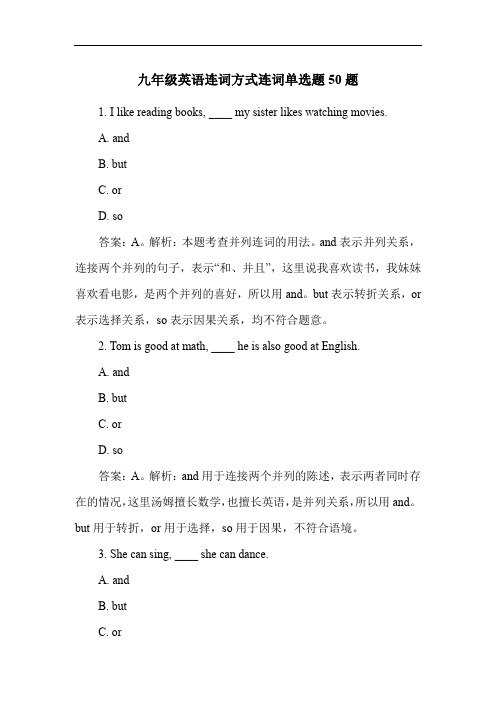
九年级英语连词方式连词单选题50题1. I like reading books, ____ my sister likes watching movies.A. andB. butC. orD. so答案:A。
解析:本题考查并列连词的用法。
and表示并列关系,连接两个并列的句子,表示“和、并且”,这里说我喜欢读书,我妹妹喜欢看电影,是两个并列的喜好,所以用and。
but表示转折关系,or 表示选择关系,so表示因果关系,均不符合题意。
2. Tom is good at math, ____ he is also good at English.A. andB. butC. orD. so答案:A。
解析:and用于连接两个并列的陈述,表示两者同时存在的情况,这里汤姆擅长数学,也擅长英语,是并列关系,所以用and。
but用于转折,or用于选择,so用于因果,不符合语境。
3. She can sing, ____ she can dance.A. andB. butC. or答案:A。
解析:句中表示她能唱歌和能跳舞这两个能力,是并列关系,and用于连接并列的内容。
but表示转折,会唱歌和会跳舞不是转折关系;or表示选择,这里不是选择关系;so表示因果,这里没有因果关系。
4. My father likes tea, ____ my mother likes coffee.A. andB. butC. orD. so答案:A。
解析:这里表示爸爸喜欢茶和妈妈喜欢咖啡这两个并列的情况,and起到连接并列内容的作用。
but是转折关系,or是选择关系,so是因果关系,都不合适。
5. The boy is clever, ____ he is hard - working.A. andB. butC. orD. so答案:A。
解析:句子表达男孩聪明和勤奋这两个并列的品质,and用于连接这种并列关系。
but表示转折,or表示选择,so表示因果,均不符合题意。
九年级上册英语Unit1 grammar知识讲解和练习-译林版(含答案)
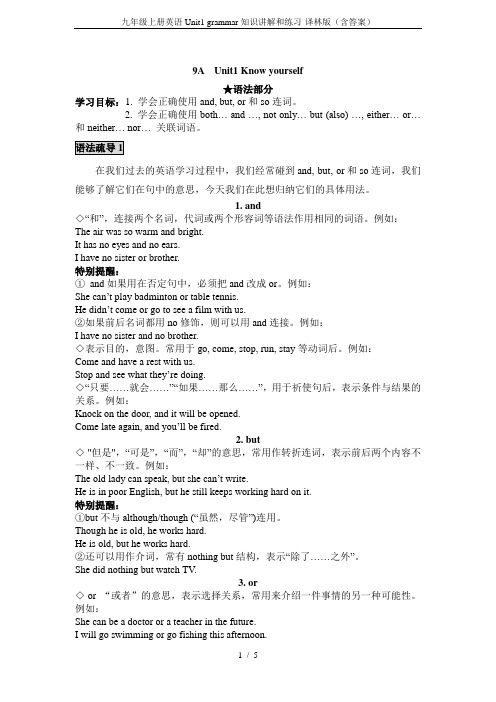
9A Unit1 Know yourself★语法部分学习目标:1. 学会正确使用and, but, or和so连词。
2. 学会正确使用both… and …, not only… but (also) …, either… or…和neither… nor… 关联词语。
在我们过去的英语学习过程中,我们经常碰到and, but, or和so连词,我们能够了解它们在句中的意思,今天我们在此想归纳它们的具体用法。
1. and◇“和”,连接两个名词,代词或两个形容词等语法作用相同的词语。
例如:The air was so warm and bright.It has no eyes and no ears.I have no sister or brother.特别提醒:①and如果用在否定句中,必须把and改成or。
例如:She can’t play badminton or table tennis.He didn’t come or go to see a film with us.②如果前后名词都用no修饰,则可以用and连接。
例如:I have no sister and no brother.◇表示目的,意图。
常用于go, come, stop, run, stay等动词后。
例如:Come and have a rest with us.Stop and see what they’re doing.◇“只要……就会……”“如果……那么……”,用于祈使句后,表示条件与结果的关系。
例如:Knock on the door, and it will be opened.Come l ate again, and you’ll be fired.2. but◇ "但是",“可是”,“而”,“却”的意思,常用作转折连词,表示前后两个内容不一样、不一致。
例如:The old lady can speak, but she can’t write.He is in poor English, but he still keeps working hard on it.特别提醒:①but不与although/though (“虽然,尽管”)连用。
人教版中考英语九年级英语 初中英语连词专项讲解及练习含答案解析

人教版中考英语九年级英语初中英语连词专项讲解及练习含答案解析一、初中英语连词1.I got up at six this morning _____________ I could catch the early bus to Nanjing.A. soB. thatC. in order toD. so that【答案】 D2.You like football ___________ she likes reading.A. WhenB. orC. becauseD. while【答案】 D3._____________ she is a very busy woman, she helps the boy.A. AlthoughB. BecauseC. HoweverD. But【答案】 A【解析】【分析】句意:虽然她是个很忙的女人,但是她帮助那个男孩。
A: Although,虽然,表示转折关系。
B: Because,因为,表示因果关系。
C: However,然而,表示转折。
D: But,但是,表示转折。
根据_____________ she is a very busy woman, she helps the boy.可知,她是个很忙的女人和她帮助那个男孩是转折关系,但用在第一个句子前,只能是although,故选A。
【点评】考查连词辨析。
注意连词的意思和区别,结合句意,选出正确答案。
4.______________ China has been a member of WTO, English is more important.A. SinceB. ThoughC. WhenD. If【答案】 A【解析】【分析】句意:自从中国加入WTO后,英语就更重要了。
since自从,though虽然;when当……时候;if如果,只有since是正确的,though放在此处句子翻译不通顺;when不和现在完成时连用;if引导从句是一般现在时或现在完成时,主句用将来时,故选A。
初三下册英语中考语法专项复习连词
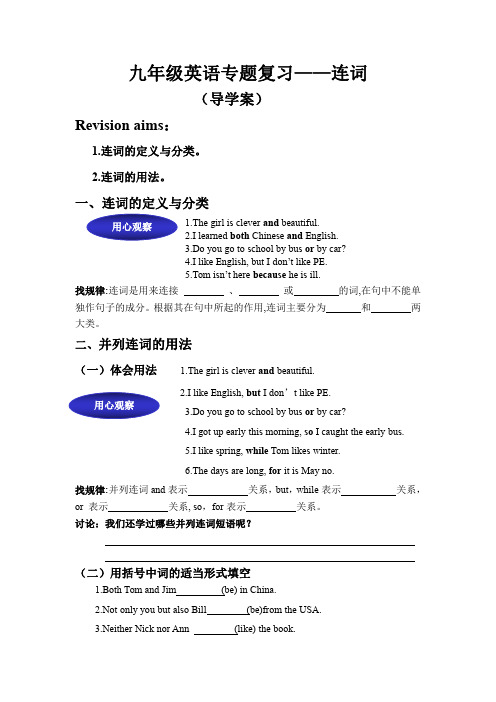
九年级英语专题复习——连词(导学案)Revision aims:1.连词的定义与分类。
2.连词的用法。
一、连词的定义与分类1.The girl is clever and beautiful.2.I learned both Chinese and English.3.Do you go to school by bus or by car?4.I like English,but I don’t like PE.5.Tom isn’t here because he is ill.找规律:连词是用来连接、或的词,在句中不能单独作句子的成分。
根据其在句中所起的作用,连词主要分为和两大类。
二、并列连词的用法(一)体会用法 1.The girl is clever and beautiful.2.I like English,but I don’t like PE.3.Do you go to school by bus or by car?4.I got up early this morning,so I caught the early bus.5.I like spring,while Tom likes winter.6.The days are long,for it is May no.找规律:并列连词and表示关系,but,while表示关系,or表示关系,so,for表示关系。
讨论:我们还学过哪些并列连词短语呢?(二)用括号中词的适当形式填空1.Both Tom and Jim(be)in China.2.Not only you but also Bill(be)from the USA.3.Neither Nick nor Ann(like)the book.4.Either you or Tom(be)right.做题技巧小结:1.both...and...连接两个主语时,谓语动词要用。
语法填空专项-10--连词讲义-2025年广东省深圳中考英语专项
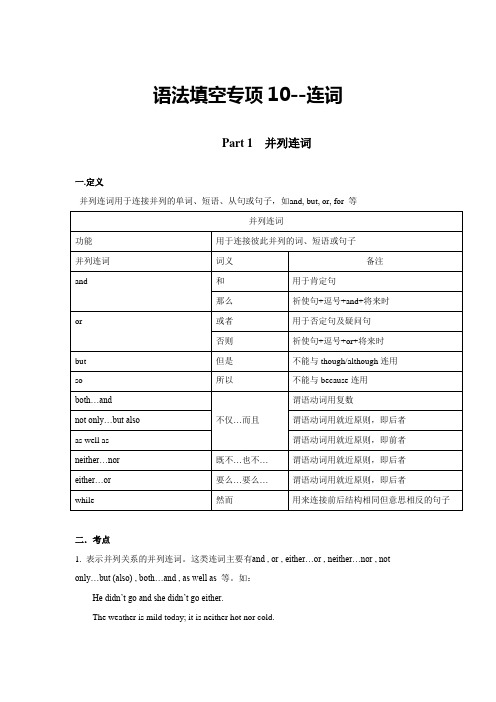
语法填空专项10--连词Part 1 并列连词一.定义并列连词用于连接并列的单词、短语、从句或句子,如and, but, or, for 等并列连词功能用于连接彼此并列的词、短语或句子并列连词词义备注and 和用于肯定句那么祈使句+逗号+and+将来时or 或者用于否定句及疑问句否则祈使句+逗号+or+将来时but 但是不能与though/although连用so 所以不能与because连用both…and不仅…而且谓语动词用复数not only…but also谓语动词用就近原则,即后者as well as 谓语动词用就近原则,即前者neither…nor 既不…也不…谓语动词用就近原则,即后者either…or要么…要么…谓语动词用就近原则,即后者while 然而用来连接前后结构相同但意思相反的句子二.考点1. 表示并列关系的并列连词。
这类连词主要有and , or , either…or , neither…nor , notonly…but (also) , both…and , as well as 等。
如:He didn’t go and she didn’t go either.The weather is mild today; it is neither hot nor cold.Both he and his mother are hungry.2. 就近一致原则由下列词语连接的并列主语“ either …or;nor; neither…nor;not only…but also;as well as”要遵循就近一致原则。
e.g. ① Neither you nor I am wrong . 你和我都没错。
②Not only you but also your father is to blame . 不仅是你,你父亲也该受责备。
习题1.We must get up early tomorrow, ______ we’ll miss the first bus to the Great Wall.A soB orC butD however2. Not only I but also Jane and Mary ______ tired of having one examination after another.A. isB. areC. amD. be3. ---I don’t like chicken ______ fish.---I don’t like chicken, ______ like fish very much.A and; andB and; butC or; andD or; but4.---Would you like to come to dinner tonight?---I’d like to, ______ I’m too busy.A andB soC asD but5.She thought I was talking about her daughter, ______, in fact, I was talking about my daughter.A. whomB. whereC. whichD. while6.Would you like a cup of coffee______ shall we get down to business right away?A. andB. thenC. orD. otherwise7.They were surprised that a child should work out the problem _____ they themselves couldn't.A. onceB. thenC. whileD. if8.The changes in the city will cost quite a lot, ______they will save us money in the long Run.A. orB. sinceC. forD. but9.Excuse me for breaking in, ______ I have some news for you.A soB andC butD yet10.---Would you like to come to the dinner party here on Saturday?---Thank you. I’d love to, _____ I ll be out of town at the weekend.A becauseB andC soD butKEYS1-5 BBDDD 6-10CCDCD二.单句填空1. They sat down _______ talked about something.2. I’d like to eat out with you tonight, _______ I’m too busy.3. Some people love cats, _______ others hate them.4. I had hardly opened the door _______ he hit me.5. The car is very old _______ in good condition.6. You can watch TV, _______ you can go to bed.7.It began to rain, _______ we went home.8. Everybody lent a hand, _______ the task was done on time.9. Stop cutting trees,_______the earth will become worse and worse.10.There is no water ______ no air on the moon.KEYS:1-5 and, but, while, when, but 6-10 or, so, and, or, and三、语法填空1Gandhi(甘地) was the father of the Indian nation. The Indians respected him with the belief [1]______ he is a national hero. He was born in India in 1869. [2]_____ is reported, he got married at the age of 13. In 1888 he sailed to England, [3] ______ he studied law for 3 years and became a lawyer. [4]_______ he returned to India, he was sent to work in South Africa. There he was surprised to find [5]_____ the problem of racial discrimination (种族歧视) was serious. Then he formed an organization and this was [6]____ he started to fight for equal rights. Gandhi returned to India in 1915, [7]_____ India was controlled by the British. He led the Indians to fight for the independence for his country. [8]______________ many Indians were put in prison, the fight never stopped. It was still not sure [9]________ they could gain independence. Finally, The British government had to give in [10]_____ India won its independence in 1947.Answer keys: that/ As/ where/ after/ that/ how/ when/ although/ whether/ and2Years ago I worked in a company as the head of the designing department. One of the bestdesigners was called Steve King,[1]___ was clever [2]___ hard-working. We didn’t know his secret [3]____he had an accident. His legs were badly hurt, [4]_____ he was taken to the hospital.[5]_____ the doctor wanted to examine his legs, he refused to take off his trousers. He told the doctor his secret [6]____ he was a woman. She loved this job [7]____ much [8]___ she had pretended to be a man in order to get it. The next day the company had a meeting about [9]_____ Ms King can stay or not. [10]______the company had never had women engineers working,we finally decided to let her stay. From then on, more women workers were employed by the company.Answer keys: who/ until/ so/ When/ that/ so/ that/ whether/ although3When you are in England you must be very careful in the streets [1]_______ the traffic drives on the left. Before you cross a street you must look to the right first [2]______ then the left. In the morning and in the evening when people go to or come from [3]______, the streets are very busy. Traffic is most [4]______ (danger) then.When you go by bus in England, you have to be careful, [5]______. Always remember the traffic moves on the left. So you must be careful. [6]______ (have) a look first, or you will go [7]______ wrong way.In many English cities, there are big buses [8]_______ two floors. You can sit on the [9]_______ (two) floor. From [10]_______ you can see the city very well. It’s very interesting.Answer keys:because/and/work/dangerous/too/Have /the /with /second /therePart 2 从属连词一、定义:用于引导从句以形成句子的一部分或修饰句子的构成要素。
2024年人教版九年级英语学考语法专项复习之连词

C.so
D.but
( C )7. A.so
B.or
C.but
D.and
Reading
1 Yesterday, we had a talent show on the Carrot Days,the topic is dream.Everyone has his dream. Some want to be astronauts, others want to be scientists. 2 My parents want me to be a carrot farmer.However,my dream is to become a police officer, because I want to make the world a better place. Besides,I can help people,I can also protect people who are in danger.Although the work of police officer is dangerous, it's still exciting and cool.To be a police officer, first,I am going to enter Zootopia Police Academy (学校). Second,I will study hard in the training and learn skills as many as possible. Finally, to build up my body, I will change my eating habits,I will do more sports,too. I am going to eat more vegetables,fruit and meat. 3 I know it is hard, but I will never give up! No pains,no gains. I believe as long as I try my best,my dream will come true some day.
(完整版)中考英语连词知识点汇总(可编辑修改word版)

中考英语连词知识点汇总一.并列连词和连词短语并列连词用来连接平行的词、词组或从句。
常见的连词有and ,but ,or ,so ,both…and , either…or ,neither…nor , not only… but also 等。
1. and1).and 表示“和、且”在肯定句中连接并列的成分。
He is laughing and talking .2).祈使句+ and …… , “and” 表示“那么”之意。
= If……Study hard , and you will succeed .= study hard , you will succeed . 3).adj / adv + and + adj /adv 表示“渐渐”。
He makes mistakes again and again .2.but表示转折关系的连词,意为“但是”He is poor ,but honest .3.or1).or 有“或”的意思,表示一种选择Would you like tea or water ?2). “祈使句……,or…”or 表示否则。
= If …not …, ……. .Study hard , or you will fail. = you study hard , you will fail .3).or 用在否定句中表示并列关系。
He can’t read or write .4.both1).both “两者都”, 后面的名词、动词都用复数。
Both the answers are right .2).both of ….Both of us are students .3).both …and…Both you and she are right .5.either/ either …or1).either “两者当中任何一个”,后有 of 时接名词的复数形式,无 of 时接单数名词,动词用单数形式。
初中英语中考语法复习连词知识讲解

中考英语语法复习连词知识讲解一、基本概念1 连词是连接单词、短语或句子的一种虚词,起辅助作用,在句子中不单独作成分。
2 根据在句子中所起的作用不同,连词通常分为并列连词和从属连词。
3 并列连词用来连接属于同一层次并具有同等句法功能的词、短语或句子;而从属连词用来连接不同层次,带有主从关系的词、短语或句子。
二、连词分类1.并列连词1.“祈使句+or+结果句”与“If you don’t…,you’ll…”同义,其中or意为“否则”。
如:Hurry up, or you will be late.快点,否则你就会迟到了!=If you hurry up, you won’t be late.如果快点,你就不会迟到了。
=If you don’t hurry up, you will be late.如果不快点,你就会迟到了。
2.but意为“但是”,用来表示转折关系,注意它不能与though, although连用。
如:I want to help you,but I really don’t know what to do.我想帮你,可是我真的不知道该做什么。
He tried hard to catch up with others,but he failed.他竭力想赶上别人,但失败了。
3.so意为“所以,因此”用来表示因果关系,注意它不能与because,since,as连用。
如:It was rather late,so we decided to go home.已经很晚了,所以我们决定回家。
The rain began to fall,so we had to find a place to stay in.雨开始下起来,所以我们不得不找个避雨的地方。
4.for意为“因为”,表示原因,主要用来进行补充说明,没有因果关系。
如:I must be off now,for it’s rather cold outside.我得走了,因为外面相当冷。
初中英语(完整)连词讲解练习答案
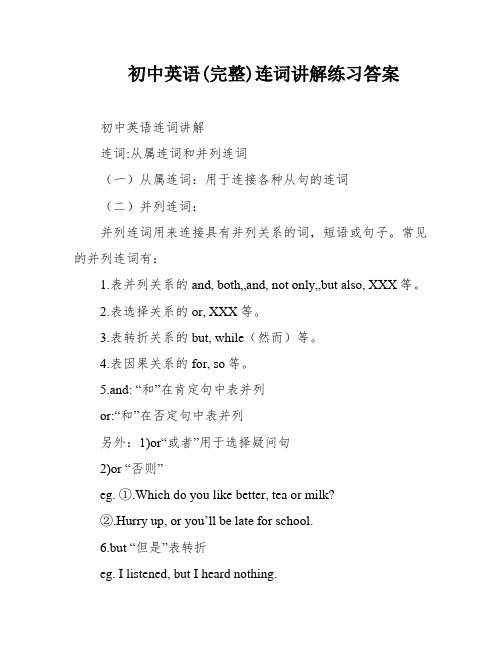
初中英语(完整)连词讲解练习答案初中英语连词讲解连词:从属连词和并列连词(一)从属连词:用于连接各种从句的连词(二)并列连词:并列连词用来连接具有并列关系的词,短语或句子。
常见的并列连词有:1.表并列关系的and, both…and, not only…but also, XXX等。
2.表选择关系的or, XXX等。
3.表转折关系的but, while(然而)等。
4.表因果关系的for, so等。
5.and: “和”在肯定句中表并列or:“和”在否定句中表并列另外:1)or“或者”用于选择疑问句2)or “否则”eg. ①.Which do you like better, tea or milk?②.Hurry up, or you’ll be late for school.6.but “但是”表转折eg. I listened, but I heard nothing.留意:1)though(固然), but(可是)不克不及连用2)not … but不是…而是eg. This book XXX.both… and : 既…又(连接主语为复数)neither…nor: 既不…也不连接两主语,后者决定单、复7.either…or: 或者…或者not only … but also:不但…而且eg.1)Both he and I are students.2)Neither he nor I am a student. 1.表并列关系的and, both…and, not only…but also, XXX等。
2.表挑选干系的or, XXX等。
3.表转折关系的but, while(然而)等。
4.表因果关系的for, so等。
5. and:“和”在一定句中表并列or:“和”在否认句中表并列另外:1)or“或者”用于选择疑问句2)or“否则”eg.①.Which do you like better, tea or milk?②.Hurry up, or you’ll be late for school.16.but“但是”表转折eg. I listened, but I heard nothing.注意:1)though(虽然), but(但是)不能连用2)not…but不是…而是eg. This book XXX.both…and :既…又(毗连主语为复数)XXX:既不…也不7. either…or:或者…或者not only…but also:不但…而且eg.1)Both he and I are students.2)XXX he nor I am a student.Ⅲ.用连词and, or,so,but填空1. Hurry up, please! _______you’ll be late for school.2. Tom was ill yesterday, ________he still went to school as usual.3. Study hard on your subjects, ________you’ll do well in the exa4. Christine, Aileen _________ I are good friends.5. Study hard, _________ you’ll fall behind.6.Many people go to play basketball, _______you can play table tennis.二.单项选择() 1. _________ John _______I are policemen.A. Neither ... norB. Either ... orC. Both ... andD. Not only... but also()2. Mr Smith teaches ______well ______ XXX.A. very ... thatB. quite ... butC. so ... asD. so ... that()3. He didn't go to sleep ______XXX.A. XXX()4. XXX ________ my aunt would give me one.A. XXX()5. The runner fell _______ he quickly got up and went on running.A. XXX()6. It was late. She washed her face ______ went to bed.A. XXX()7. You may pay attention to your writing ______ nobody can understand what you want towrite.A. XXX()8. XXX cup _______ asked for some more tea.A. XXX()9. Study harder, ______ you will fall XXX.A. XXX()7. _______ Sunday ______Monday is OK. I’ll be free during those two days.A. XXX()8. We haven’t seen him ________ he left last year.A. XXX2()9. It’s raining now, ________ you must take the raincoat with you.A. forB. soC. orD. because()10._______you work harder, you’ll do better in your subjects.A. XXX()11.________I was XXX, I did n’t come to school.A. XXX()12.The old man was _______ pleased ______he could not say a word.A. either…orB. neither…norC. not only…but alsoD. so…that()13.Which is bigger, the sun _____the earth?A. XXX()14. Could you tell us _______XXX()15.He knew nothing about the accident _______ his XXX()16.XXX loud voice _____all the class can hear you.A. so thatB. so (XXX)()17.In the old days the poor children couldn’t go to school. They could ______read ___ XXX.A. both…andB. either…orC. not only…but alsoD. neithe r…nor()18._____ Australia is very large, the population is quite small.A. XXX()e here early tomorrow, ______you’ll see her.A. XXX()20.Neither she ________ I am a teacher. We are both students.A. orB. andC. norD. but()21.He kept quiet ______XXX.A. XXX()22._______ I am washing, she is cooking.A. XXX as()23.She had to do everything ________ her husband died.A. XXX()24.XXX ________ she began to learn English.A. XXX()25.She has had another baby ________ we met.A. XXX()26.I knew nothing about it ________ XXX.A. XXX()27.I’ll ring you up, ______ I get an answer from him.A. XXX()28.We couldn’t go quickly ______ the road was too slippery.(滑)A. XXX()29._____ it is fine tomorrow, I’ll go to the park.A.XXX()30.I don’t know _______ you like sports .3A. XXX()31.Water is XXX life _______XXX()32.She sat in the first row ______ she could see the XXX()33.I’ll go to see my sister _______ I get to New York.A. XXX()34. I’m XXX(保姆). She must be _______ too old _______ too young .A. neither ; norB. both ; andC. either ; orD. not only ; but also()35. Which is bigger , the sun _______ the moon ?A. orB. andC. butD. so()36Why not look up the new word in a dictionary _______ you don’t know it ?A. ifB. thatC. thoughD. whether()37_______ all the passengers are here , why don’t we start at once ?A. As soon asB. AfterC. Now thatD. When()38He hurt her _______ badly _______ she had to see a doctor .A. too ; thatB. so ; thatC. either ; orD. too ; to()39Lucy has seen the film , _______ Lily hasn’t .A. andB. orC. butD. so.()40 Hurry up , _______ we will miss the trian .A. butB. andC. orD. so()41.—I’m XXX weekend .—_______ you are there , can you buy me some green tea ?A. BecauseB. WhileC. IfD. Though()42.___he was out of the room , he turned back and XXX.A. Before B. Since C. As soon as D. Until()43. Study hard , _______ you’re sure to have a good result in the exam !A. butB. andC. forD. or()44I can’t understand this passage _______ there are no new words in it .A. ifB. becauseC. thoughD. and练:1. _________ John _______I XXX.A. XXX ... XXX ... or4C. Both ... andD. Not only... but also2. Mr Smith teaches ______well ______ XXX.A. very ... thatB. quite ... butC. so ... asD. so ... that3. He didn't go to sleep ______XXX.A. XXX4. XXX ________ my aunt would give me one.A. XXX5. XXX fell _______ he quickly got up and went on running.A. XXX6. Wait for me in the room _______ I come back.A. XXX7. I'll return the books to the library ______ XXX.A. XXX8. Go along the road, _______ you'll find the market at the end of it.A. XXX9. You'll be late ______ XXX.A. XXX10. It was late. She washed her face ______ went to bed.A. XXX练()1.___ the afternoon of May, we visited the old man.A. XXX()2.Many people work ___ the day and sleep ___ night.A. on ; atB. in ; inC. in ; at()3.He speaks Japanese best ____ the boy students.A. XXX()4.A wolf ___ a sheep skin is our dangerous enemy.A. XXX()5.Joan hopes to come back ___ three days.A. XXX()6.They XXX ___ mistake.A. XXX()7.He left home ___ a cold winter evening.A. XXX()8.Shanghai is ____ the east of China.A. XXX()9.____ my father’s help, I have XXX.A. XXX()10.He’s very strict ____ himself and he’s very strict ___ his work.A. with ; inB. in ; withC. with ; with()11.I really can’t agree ____ you.XXX5()12.The shop won’t open ___ nine in the morning.A. XXX()13.How about ___ the flowers now?A. XXX()14.XXX his money ___ books.A. XXX()15.They are talking ___ XXX.A. XXX()16.It’s very kind ___ you to help us.A. XXX()17.What will you have ___ breakfast this morning?A. XXX()18.A plane is flying ____ the city.A. XXX()19.You are free to speak ___ the meeting.A. XXX()20.Mr. Green will stay in China___ Friday.XXX()21.It’s wrong to play tricks ___ other people.A. XXX()22.Which color do you like? I prefer blue ___ red.A. forB. asC. to()23.The student will give us a talk ___ how to use our spare time.A. XXX()24.I paid two hundred yuan ___ that kind of bicycle.A. XXX()25.The doctor is very kind ___ his patientsXXX()26.We can’t live ___ air.A. XXX()27.The child was afraid ___ the XXX()28.He was very angry ___ her for being XXX()29.What do you think ___ the play?A. XXX()30.I think it’s the right way to work out the problem, but I am not sure _____ it.XXX()31.Reading ___ the sun isn’t good ___ youA. under ; forB. in ; forC. in ; to()32.I won’t ask about it, I’m going to see it ____ my own eyes.A. XXX()33.We go to school every day ____ XXX()34.There is a small river ___ the two XXX()35.Li Lei sometimes falls asleep ___ XXX()36.Mr. Black went to Paris ___ a few days.A. XXX6()37.They will leave ________ XXX.XXX()38.Are you going to the zoo ___ bus or ___ my car?A. on ; byB. by ; inC. on ; in()39.He woke up several times ___ the nightA. XXX()40.No one can stop her ___ going away.A. ofB. fromC. out of()41.What do you mean ___ “bao zhi”?A. XXX()42.You’ll get a nice present ____ your parents____ your birthday.A. from ; onB. for ; atC. frm ; in()43.Light comes in ____ the window.A. XXX()44.There are many apples ___ the tree. A bird ___ the tree is picking an apple.A. in ; onB. on ; inC. in ; at()45. “Who are you going to play ____?”“Grade Two.”A. XXX()46. Don’t go ___ the street. The bus is coming.A. XXX()47.He lives ___ XXX ___ No. 154 Zhongshan Street.A. on ; atB. in ; inC. on ; in()48.He found a piece of useful information ___ the Internet.A. XXX()49.___ my surprise, XXX.A. XXX()50.The blind man knows the money ___ XXX it.A. XXX()51. XXX Parisand arrived _______ 5 o’clock ______ the morning.A. on; inB. at; inC. at; onD. in; on()52. Where’s Lily? We are all here _______ her.A. XXX()53. She sent her friend a postcard _______ XXX.A. XXX()54. Jack has studied Chinese in this school _______ the year of 2000.A. XXX()55. ---What is a writing brush, do you know?---It’s _______ writing anddrawing.A. XXX()56. English is widely used ______ travellers and business people all over the world.XXX()57. ______ the help of my teacher, I caught up with the other students.A. XXX()58. Hong Kong is _____the south of China, and Macao is ____ the west of Hong Kong.7A. in; toB. to; toC. to; inD. in; in()59. ---You’d better not go out now. It’s raining.---It XXX ______ rain.A. XXX()60. Japan lies ______ the east of China.XXX()61. ---Will the foreigners have any problems talking with Chinese in 2008?---I don’t think so. Now ______ the young ______ the old can speak some English.XXX()62. We didn’t catch the train _______ w e left late.A. XXX()63. Tom failed in the exam again _______ he wanted to pass it very much.A. XXX()64. I won’t believe that the five-year-old boy can read five thousand words ______ I XXX.A. XXX()65. The book was so interesting that he had read it for three hours ______ he realized it.A. XXX()66. ---This dress was last year’s style.---I think it still looks perfect ______ it has gone out this year.A. so thatB. even thoughC. as ifD. ever since()67. Hurry up, _______ you will miss the train.A. XXX()68. The mountain was ______ steep _____ few people in our city reached the top.A. XXX()69. ---Do you XXX’an?---Of course. I remember everything ______ it XXX.A. XXX()70. ___you can’t answer this question, we have to ask someone else for help.A. XXX中考总温专练(12)(连词)1. I’m XXX(保姆). She must be _______ too old _______ too young .A. neither ; nor B. both ; and C. either ; or D. not only ; but also2. Which is bigger , the sun _______ the moon ?A. orB. andC. butD. so3. Why not look up the new word in a dictionary _______ you don’t know it ?A. if B. that C. though D. whether4. _______ all the passengers are here , why don’t we start at once ?8A. As soon asB. AfterC. Now thatD. When5. He hurt her _______ badly _______ she had to see a doctor .A. too ; thatB. so ; thatC. either ; orD. too ; to6. Lucy has seen the film , _______ Lily hasn’t .A. andB. orC. butD. so7. Hurry up , _______ we will miss the trian .A. butB. andC. orD. so8.—I’m XXX weekend .—_______ you are there , can you buy me some green tea ?A. BecauseB. WhileC. IfD. Though9. _______ he was out of the room , he turned back and knocked at the teacher’s door again .A. Before B. Since C. As soon as D. Until10. Study hard , _______ you’re sure to have a good result in the exam !A. but B. and C. for D. or11. I can’t understand this passage _______ there are no new words in it .A. if B. because C. though D. and初中英语连词挑选题精选1. He can speak English_______ Chinese.A. butB. alsoC. soD. and2. Physics is not so easy, _______I like it very much.A. butB. orC. sinceD. because3. Will Tom wait for her at home ______ at the library?A. orB. asC. so thatD. both4. She has a son _______ a daughter.A. butB. andC. soD. or5. I'll give her the gift ______ she arrives.A. soB. beforeC. as soon asD. since6. Tom was ____ill that we had to send for a doctor.9A. soB. veryC. andD. too7. The woman was____ angry_____ XXX.A. neither…norB. either…orC. both…andD. so…t hat8. ______we got home it was very late.A. WhenB. WhileC. BecauseD. As9. We heard clearly_____ she said.A. whatB. whichC. beforeD. because10. I can't sleep well at night, ______I often feel very tired in the day.A. so B. because C. and D. or11. When you're learning a foreign language, use it, ______ you will lose it.A. but B. or C. then D. and12. --- Can you play football?--- Yes, I can, ______ I can't play it very well.A. orB. andC. butD. so13. Study hard, ______ you will fall behind.A. andB. butC. soD. or14. My favorite is action movie ______ I think it's exciting.A. andB. becauseC. butD. so15. The boy is very smart, ______ many of his classmates like him.A. but B. so C. or D. for16. He has never heard______ XXX.A. norB. andC. orD. since17. _________ John _______I XXX.A. XXX ... norB. Either ... orC. Both ... andD. Not only... but also18. Mr Smith teaches ______well ______ XXX.A. very ... that B. quite ... but C. so ... as D. so ... that19. He didn't go to sleep ______XXX.A. tillB. beforeC. afterD. until20. XXX ________ my aunt would give me one.10A. untilB. becauseC. ifD. before21. XXX fell _______ he quickly got up and went on running.A. or B. and C. but D. down22. Wait for me in the room _______ I come back.A. untilB. andC. soD. or23. I'll return the books to the library ______ XXX.A. asB. soC. justD. but24. Go along the road, _______ you'll find the market at the end of it.A. when B. and C. or D. though25. You'll be late ______ you don't get up early tomorrow morning.A. if B. when C. before D. until26. It was late. She washed her face ______ went to bed.A. orB. andC. soD. but【现场练兵】I.选择填空()1. XXX cup _______ asked for some more tea.A. XXX()2. Study harder, ______ you will fall XXX.A. XXX()3. The doctors are very tired, _______ they are still working very hard.A. XXX()4. _____ you come back, please let me know.A. XXX as()5. He told us _______ he was over eighty years old.A. XXX()6. Don’t go home _______ you have cleaned the classroom.A. XXX()7. _______ Sunday ______Monday is OK. I’ll be free during those two days.A. XXX()8. We haven’t seen him ________ he left last year.A. XXX()9. It’s raining now, ________ you must take the raincoat with you.A. forB. soC. orD. because()10._______you work harder, you’ll do better in your subjects.A. XXX()11.________I was XXX, I didn’t come to school.A. XXX11()12.The old man was _______ pleased ______he could not say a word.A. either…orB. neither…norC. not only…but alsoD. so…that()13.Which is bigger, the sun _____the earth?A. XXX()14. Could you tell us _______XXX()15.He knew nothing about the accident _______ his XXX()16.XXX loud voice _____all the class can hear you.A. so thatB. so (XXX)()17.In the old days the poor children couldn’t go to school. Theycould ______read ___ XXX grew up.A. both…andB. either…orC. not only…but alsoD. neither…nor()18._____ Australia is very large, the population is quite small.A. XXX()e here early tomorrow, ______you’ll see her.A. XXX()20.Neither she ________ I am a teacher. We are both students.A. orB. andC. norD. but()21.He kept quiet ______XXX.A. XXX()22._______ I am washing, she is cooking.A. XXX as()23.She had to do everything ________ her husband died.A. XXX()24.XXX ________ she began to learn English.A. XXX()25.She has had another baby ________ we met.A. XXX()26.I knew nothing about it ________ XXX.A. XXX()27.I’ll ring you up, ______ I get an answer from him.A. XXX()28.We couldn’t go quickly ______ the road was too sl ippery.(滑)A. XXX()29._____ it is fine tomorrow, I’ll go to the park.A.XXX()30.I don’t know _______ you like sports .A. XXX()31.Water is XXX life _______XXX()32.She sat in the first row ______ she could see the XXX()33.I’ll go to see my sister _______ I get to New York.12A. XXX()34.There were ______ many pains in my chest ______ I couldn’t help crying.A. so…asB. so thatC. so…thatD. such…that()35.Ten years has passed _____we left our hometown.A. XXX()36.I’m sorry _________your leg has broken.A. XXX()37.Could you tell me _____ the foreigner have come or not?A. XXX()38.I wondered ______ he had been to Paris.A. XXX()39.______ you hurry, you will be late for school.A. XXX()40.Could you please look after my daughter ______ I go shopping?A. XXX中考总复专练(12)(连词)参考答案:1. A2. A3. A4. C5. B6. C7. C 8. B 9. C 10. B 11. C。
中考英语知识点梳理连词专项

中考英语知识点梳理连词专项连词是用来连接各种句子成分的词语,使句子结构完整和通顺。
以下是中考英语中常见的连词及其作用:1.并列连词:- and:表示并列关系,连接同类事物或同类动作。
- but:表示转折关系,连接相对或对比的两个句子。
- or:表示选择关系,连接两个或多个选项,其中的一个会发生。
- so:表示因果关系,连接原因和结果。
- for:表示原因关系,连接原因和结果。
2.时间连词:- when:表示时间关系,连接时间点。
- while:表示时间关系,连接两个同时进行的动作。
- before:表示时间关系,连接发生在另一个事件之前的动作。
- after:表示时间关系,连接发生在另一个事件之后的动作。
- since:表示时间关系,连接从过去其中一时间点开始一直延续到现在的动作。
3.原因连词:- because:表示原因关系,连接原因和结果。
- as:表示原因关系,连接原因和结果。
- since:表示原因关系,连接原因和结果。
4.结果连词:- so:表示结果关系,连接原因和结果。
- therefore:表示结果关系,连接原因和结果。
- thus:表示结果关系,连接原因和结果。
5.条件连词:- if:表示条件关系,连接条件和结果。
- unless:表示条件关系,连接条件和结果。
6.让步连词:- although:表示让步关系,连接两个相对的句子。
- though:表示让步关系,连接两个相对的句子。
- even though:表示让步关系,连接两个相对的句子。
7.比较连词:- as...as:表示比较关系,连接两个相对的句子。
- not as/so...as:表示比较关系,连接两个相对的句子。
- than:表示比较关系,连接两个相对的句子。
8.目的连词:- in order to:表示目的关系,连接目的和动作。
- so as to:表示目的关系,连接目的和动作。
以上是中考英语中常见的连词及其作用。
专题08 连词-初中英语重要语法精讲精练(江苏专用)

专题08 连词连词的定义:用来连接词、短语或句子的词。
eg: Joan was rich, beautiful and proud. (and 连接单词)He likes to play football and sing popular songs.(and 连接短语)Go straight on and you will see the church. (and 连接句子)连词的分类并列连词连词: and, but, or, so, for 等 连词词组: either…or, neither…nor, not only…but also, both…and 等 从属连词that,whether, if, unless, while / when, until, because, so that, so…that, though/ although 等考点一:and/ but /or/ so(1)and :和;而且;又;然后①表示联合,意为“和、又、而且” 有时用于连接两个相同的词语,表示事物连续性 eg:The train ran faster and faster.①and 这样的话,就会……,相当于一个肯定条件句eg:Study hard, and you can get good grades.(If you study hard, you can get good grades.)“ and”1. He got up and left the room.2. He went to Kunming and I went Harbin last year. 并列连词从属连词连词: and, but, or, so, for 等 连词词组: either…or, neither…nor, not only…but also, both…and 等 that,whether, if, unless, while / when, until, because, so that, so…that, though/ although 等特别用法: 句型“祈使句, and …”= If you…, you will…3. Work hard, and you will do well in the exam.58(2)or:或;否则1. or 否则相当于一个否定条件句。
(人教版)九年级中考英语专题复习:连词用法详解(含解析)

(人教版)九年级中考英语专题复习:连词用法详解(含解析)(人教版)九年级中考英语专题复习:连词用法详解(含解析)-CAL-FENGHAI-(2020YEAR-YICAI)_JINGBIAN初中英语分类练习——连词部分连词在句中的作用是把词与词、短语与短语、句子与句子连接起来。
它不能在句中单独作句子成分。
知识点概述并列连词和从属连词的用法连词是连结单词、短语、从句或句子的虚词,在句子中不单独作句子成份。
连词按其性质可分为:1.并列连词如:and, or, but, for, 等,连接并列的词与词,短语与短语,句子与句子。
如:Rice and potatoes are common foods. (词与词)Today we can travel by plane. (短语与短语)Many trees lose their leaves in winter, but evergreen trees do not. (句子与句子)关联连词是一类成对使用的连词如:both……and……, not……but…….not only……but also…… not only…but… as welleit her……or…… neither……nor……关联连词必须后接同样的语法结构。
如:Either the windows were opened or the door was opened.2.从属连词如:that, whether, when, because, though 等,用以引导名词性从句和状语从句。
3.从属连词引导的从句不可以被断成一个句子。
如果断开,就错了。
如:When the alarm clock rang. (不完整)4. though (although)引导让步状语从句,because引导原因状语从句,所以though(although)不能和并列连词but ,because 不能和并列连词 so一起使用。
九年级英语 连词知识点
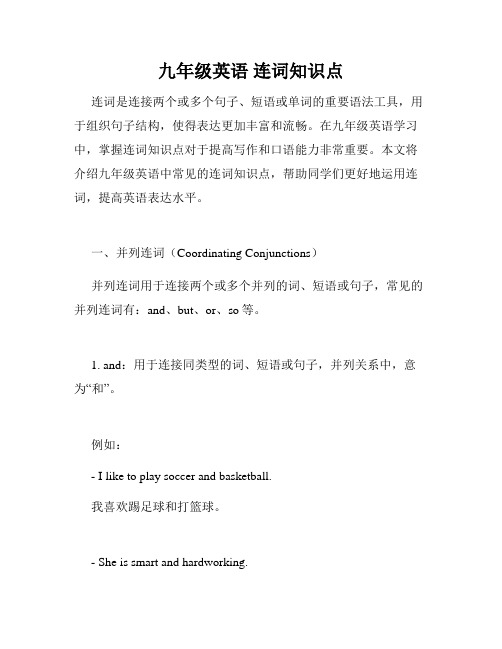
九年级英语连词知识点连词是连接两个或多个句子、短语或单词的重要语法工具,用于组织句子结构,使得表达更加丰富和流畅。
在九年级英语学习中,掌握连词知识点对于提高写作和口语能力非常重要。
本文将介绍九年级英语中常见的连词知识点,帮助同学们更好地运用连词,提高英语表达水平。
一、并列连词(Coordinating Conjunctions)并列连词用于连接两个或多个并列的词、短语或句子,常见的并列连词有:and、but、or、so等。
1. and:用于连接同类型的词、短语或句子,并列关系中,意为“和”。
例如:- I like to play soccer and basketball.我喜欢踢足球和打篮球。
- She is smart and hardworking.她聪明且勤奋。
2. but:连接两个相反意义或者对比的内容,意为“但是”、“而”。
例如:- He is rich, but he is not happy.他富有,但不快乐。
- She is tired but happy.她虽然累,但是快乐。
3. or:用于表示选择、二者择一,意为“或者”。
例如:- Do you want tea or coffee?你想要茶还是咖啡?- You can choose to take the bus or walk to school.你可以选择坐公交车或步行上学。
4. so:表示因果关系,意为“所以”。
例如:- It is raining, so we can't go out.下雨了,所以我们不能出去了。
- She studied hard, so she passed the exam.她学习努力,所以考试通过了。
二、从属连词(Subordinating Conjunctions)从属连词用于连接一个主句和一个从句,常见的从属连词有:because、although、while、when等。
1. because:表示原因,意为“因为”。
中考英语连词、复合句讲解
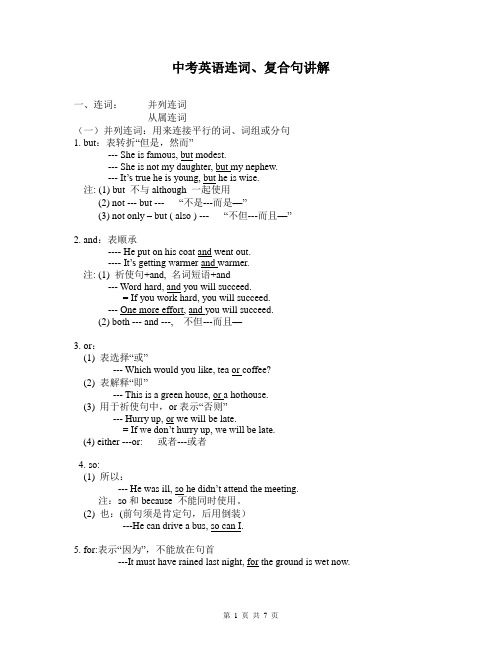
中考英语连词、复合句讲解一、连词:并列连词从属连词(一)并列连词:用来连接平行的词、词组或分句1. but:表转折“但是,然而”--- She is famous, but modest.--- She is not my daughter, but my nephew.--- It’s true he is young, but he is wise.注: (1) but 不与although 一起使用(2) not --- but --- “不是---而是—”(3) not only – but ( also ) --- “不但---而且—”2. and:表顺承---- He put on his coat and went out.---- It’s getting warmer and warmer.注: (1) 祈使句+and, 名词短语+and--- Word hard, and you will succeed.= If you work hard, you will succeed.--- One more effort, and you will succeed.(2) both --- and ---, 不但---而且—3. or:(1) 表选择“或”--- Which would you like, tea or coffee?(2) 表解释“即”--- This is a green house, or a hothouse.(3) 用于祈使句中,or表示“否则”--- Hurry up, or we will be late.= If we don’t hurry up, we will be late.(4) either ---or: 或者---或者4. so:(1) 所以:--- He was ill, so he didn’t attend the meeting.注:so和because 不能同时使用。
- 1、下载文档前请自行甄别文档内容的完整性,平台不提供额外的编辑、内容补充、找答案等附加服务。
- 2、"仅部分预览"的文档,不可在线预览部分如存在完整性等问题,可反馈申请退款(可完整预览的文档不适用该条件!)。
- 3、如文档侵犯您的权益,请联系客服反馈,我们会尽快为您处理(人工客服工作时间:9:00-18:30)。
初三英语语法知识点专题讲解练习----连词一.概念连词是用来连接词,短语,从句或句子的词.连词在句子不能独立充当句子的成分。
.二.知识点精讲(按语法含义分类)(一)并列连词有and, or, but, for, both, either, etc.1.“and”用来连接对等的句子,短语或句子Sam enjoys tennis, table tennis and basketball.The weather became colder and colder.He stood up and went out of the classroom.注意:祈使句后连接and,有条件句作用。
Go straight on, and you'll see the library.=If you go straight on, you'll see the library.2.表示选择关系,有:or, either…or…,whether… or…等。
(“or”作“或、否则”之意)1)祁使句后连接or ,表“如果…,否则…”,有转折的意思,此时or =if you don’t …,you’ll …Hurry up, or you’ll be late.=If you don’t hurry up, you’ll be late.2)either…or…:或者…或者…; 不是…就是…;要么…要么…a.either…or…连接两个并列主语时,谓语动词靠近哪个主语就与哪个主语保持“人称”和“数”的一致,即就近原则。
Either you or I am right.b.由either…or…引导的否定句是完全否定。
She isn’t either a student or a teacher.c.whether…or…不管…还是…She is always cheerful, whether at home or at school.3.表示转折关系,有:but, however, yet, still,while等。
but表示转折,while表示对比。
(1.although、though 不可以与but 连用,但是可以与yet和still连用, 2. not … but 不是…而是)Mary was a nice girl, but she had one shortcoming.Tom got up early, yet he failed to catch the train.He was very tired, still he kept on walking.Your composition is fairly good, however, there is still some room for improvement.Jane is hard working ,while her sister is quite lazy.4.both… and : 既…又(连接主语为复数)neither…nor: 既不…也不either…or: 或者…或者连接两主语后者决定单、复not only … but also:不但…而且5.表示因果关系,有:for(因为),so(所以)。
He is not at school today, for he has a bad cold.It was late, so I went home.(二).从属连词的用法:1.引导时间状语从句,有:before, after, when, while, as, till, until, since, as soon as等。
After they had planted their crops, they took a rest.We have learned six lessons since he began to teach us.As soon as he gets to Beijing, he’ll call me.1) w hen, while, as 都表示“当……时”,when从句谓语动词既可以是瞬间动词也可以是延续性动词,可用于主从句动作同时发生或从句动作先于主句动作发生。
while从句谓语动词只能是延续性动词,侧重主从句动作同时发生。
as引导一个持续性动作,多用于主从句动作同时发生,强调“一边……一边”。
When I came in, my father was cooking.I came in when/while my father was cooking.He sang as he walked.2)until用法:1.当主句谓语动词是延续性动词时,主从句都用肯定式,译为“直到……为止”(do sth until...);当主句谓语动词是瞬间时,主句用否定式,从句用肯定式,即not…..until, 译为“直到……才”。
Until=till (till不能放在句首)Mr. Green waited until his children came back.(格林先生一直等到他的孩子们回来)Mr. Green didn’t go to bed until his children came back. (格林先生直到他的孩子们回来才睡觉)2. 引导条件状语从句,有:if(如果), unless(除非,如果……不)等。
If you don’t go soon, you’ll be late.=Unless you go soon, you’ll be late.3.引导原因状语从句,有because, as, since等。
because“因为”语气最强,回答why提问时只能用because,其引导的从句可放在句首或句末;as“由于”、since“既然”语气不如because强,引导的从句常置于句首;for是并列连词,不能置于含两个并列分句的句子的句首,只能将其放在两个分句中间。
He didn’t go to school because he was ill.As it was raining, we went there by bus.Since everybody is here, let’s begin.It must have rained last night, for the ground is wet.注意:because与so不能同时使用。
8.引导让步状语从句,有:although/though(虽然,尽管), even though/if (即使)Although/ Though it is a very young country, it is very rich.Even if/ though you were here yesterday, you couldn’t help him.注意:although/though 引导的从句不能与but连用,但可与yet, still连用。
9.引导目的状语从句,有so that和in order that(以便,为了)等。
The teacher spoke loudly so that /in order that we could hear him clearly.10.引导结果状语从句,有:so that(结果是)和so/such…that…(如此…以至于)等。
so…that与such…that之间的转换既为so与such之间的转换。
比较so和such 其规律由so与such的不同词性决定。
such 是形容词,修饰名词或名词词组,so 是副词,只能修饰形容词或副词。
so 还可与表示数量的形容词many,few,much,little连用,形成固定搭配。
so + adj.such + a(n) +adji+ n.so + adj. + a(n) + n.such + adj+n. (pl.)so + many(few) adj. + n. (pl.)such +n. (pl.)/such+a(n)+n.so + much(little) adj. + n. [不可数]such +adj+n. [不可数]It was very cold, so that the water in the bowl froze.He got there so early that he got a good seat.It is such a heavy box that nobody can move it.11.引导比较状语从句,有:as…as…(与……一样),not as/so… as…(不及,赶不上),和than(比)等。
I know you better than she does.He works as carefully as she.I can’t run as/so fast as you.12.引导名词性从句,有:that和if/whether(是否)等。
We know that the earth goes around the sun.(宾语从句)I wonder if he has received my e-mail. (宾语从句)注意:在时间状语从句和条件状语从句中,如果主句是将来时,从句要用一般现在时。
I’ll go on with the work when I come back tomorrow.★连接性副词:however,therefore,besides,moreover, what’s more,otherwise,anyway,instead, anyway, as a result等。
★阅读中常见关联词:as if 犹如,好似as though 好像;仿佛as well as也;和…一样;不但…而且even though虽然,即使even if即使;虽然ever since adv. 从那时到现在now that既然;由于yet conj. 但是;然而adv. 还;但是;已经anyway adv. 无论如何,不管怎样;总之all the same仍然still conj. 仍然;但是;尽管如此rather than 而不是;宁可…也不愿中考模拟题:类型一:考察并列连词:1、I don’t like reading watching TV. What about you? “I don’t like reading all day, I like watching TV play s.”A.and, but B.and, and C.or, and D.or, but2、We bought Granny a present, she didn’t like it.A. but B.and C.or D.so3、He is only ten months. He can read write.4、She said she might come Saturday Sunday5、If Tom Mike asks for their car, tell him to come tomorrow.6、My shoes are worn out, I need new ones.类型二:考察从属连词:1、You won’t know the value(价值) of the health you lose it.2、It was already ten o’clock we got to the museum this morning.3、It’s a long time we met last.4、I’ll give her the message she comes back.5、the teacher came into the classroom, many students were talking to each other.6、People often mistake us for each other we are twins.7、Read the sentences slowly we can understand what you read.1. —Oh, I failed again—Don’t lose heart. One more effort, ________ you will succeed.A. so thatB. thereforeC. howeverD. and2. _______a difficult situation, so you should send him a message and give him some advice.A. As he is inB. He is inC. Being inD. He being in3. She said she would work it out herself, ________ ask me for help.A. and not toB. but notC. and prefer notD. rather than4. ________ enough time, but I couldn’t do it better.A. I was givenB. GivenC. To be givenD. Though I was given5. —How can I wake up so early? —Set the alarm at 5 o’clock, ________ you’ll make it.A. butB. orC. andD. so6. For a person with reading habits, a printed page contains not only words ____ ideas, thoughts and feelings.A. yetB. andC. orD. but7. Information technology is taught in most schools, ________ we have entered the information society.A. soB. whileC. stillD. for8. English is understood all over the world ______ Turkey is spoken by only a few people outside Turkey itself.A. whileB. whenC. ifD. as9. I was on the point of going to bed ________ Mr. Zhang rang.A. asB. whenC. whileD. and10. I asked him whether he had done all the work himself ________ whether he had had any assistance.A. andB. butC. norD. or11. In some countries, ______are called “public schools” are not owned by the public.A. whichB. asC. whatD. that12. ________ happens in the world makes us happy and sad by turns.A. ThatB. WhatC. WhichD. Whether13. I read about this story in some book or other, does it matter ________ it was?A. whereB. whatC. howD. which14. One of the men present held the view ________ the book said was right.A. what thatB. whatC. thatD. that what15. ________ I had walked for six hours, I was tired out.A. AfterB. BeforeC. WhenD. As16. Tom make up his mind to get a seat for the football match ________ it means standing in a queue all night.A. as ifB. as thoughC. even ifD. whatever17. The roof fell ________ he had time to dash into the house to save his baby.A. asB. afterC. untilD. before18. Doing your homework is a sure way to improve your test scores, and this is especially true ____ it comes to classroom tests.A. asB. sinceC. whenD. after19. I have been keeping that photo ________ I can see it every day, as it always reminds me of my college days.A. whichB. whereC. whetherD. when20. You may borrow this book --- ________ you promise to give it back.A. in caseB. so long asC. as ifD. even if21. ________ the man grew older, he lost interest in everything except gardening.A. WithB. SinceC. WhileD. As22. ________ you understand this rule, you’ll have no further difficulty.A. OnceB. UnlessC. AsD. Until23. I had no sooner got back to the kitchen _______ the door-bell rang loud enough to wake the dead.A. whenB. thanC. asD. while24. I criticized him, you know, not ________ I hate him but ________ I love him.A. because; becauseB. because; forC. for; becauseD. for; for25. ________ he studies hard, he will never pass the examination.A. IfB. UnlessC. Even ifD. Even though26. She worked hard _____ everything would be ready by the time he came back.A. sinceB. so thatC. as ifD. unless27. He waited ________ the volcano became quiet and he was able to return two days later.A. whenB. beforeC. asD. until28. — May I go and play football with Dick this afternoon, Dad? — No, you can’t go out ________ your work is being done.A. beforeB. untilC. asD. after29. A warning news report from Qatar announces that a group of Islam will continue to kill Americans wherever they are _____ ___ they leave the Arab world forever.A. even thoughB. in caseC. wheneverD. until30. I was so familiar with her that I recognized her voice ________ I picked up the phone.A. the momentB. afterC. beforeD. while。
